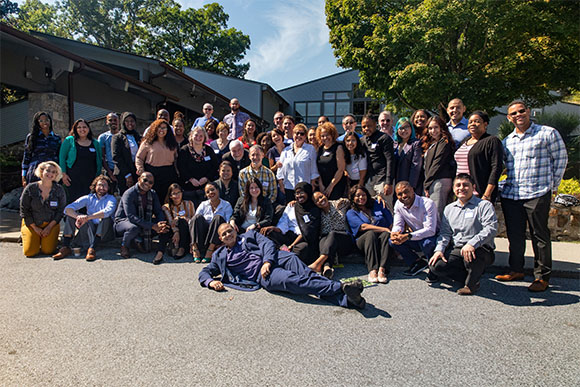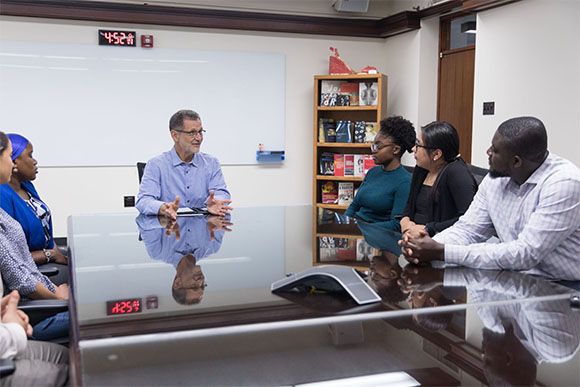|
Note: The name of this newsletter has been changed from Momentum to In Depth to provide further clarity about its focus.
90X30 - Fulfilling Our Mission
The 90X30 challenge – our effort to award 90,000 high-quality degrees and credentials by 2030 – has been a repeated topic of discussion over the past three years, with good reason. Aiming to award an additional 5,000 Bachelor’s and 1,500 graduate degrees more than projections based on past trends, 90X30 arises from Lehman College’s deepest values: educating, empowering and engaging students.
Some may wonder whether the 90X30 aspiration truly reflects what Lehman College is and what we should strive to achieve, or whether, given the college leadership transitions, it remains a guiding idea. There are other questions too:
- Is 90X30 achievable?
- If so, at what cost?
- Will the pursuit of such a specific numerical goal jeopardize other less quantifiable but no less valuable goals of a Lehman education?
- How do the Strategic Growth and Investment Plan (SGIP) and our current Strategic Planning process fit with 90X30?
In this month’s In Depth newsletter, I would like to provide a 90X30 update, as well as respond to some of these important questions.
The origins and reasons for the 90X30 Challenge
What is 90X30, and what makes it so significant for Lehman College? Former President José Luis Cruz announced the 90X30 challenge in 2017. Subsequently, alumni, external stakeholders, faculty and college administrators drafted an implementation plan for achieving the ambitious goal of increasing the number of Bronx residents with Bachelor’s degrees, graduate degrees, and professional credentials. It was obvious that 90X30 could be instrumental in the Bronx’s economic renewal.
In New York City overall, adults 25 and older earn degrees at a rate that is more than double that of Bronx residents – 43.14 percent versus 19.4 percent, respectively. Increasingly, good jobs require at least a Bachelor’s degree. That means a widening educational attainment gap has profound consequences in the Bronx. Persistent poverty, health inequities, high food and housing insecurity in the lives of our students and their families can be overcome with educational attainment.
 Lehman College's Commencement 2019 Lehman College's Commencement 2019
College graduates have lifetime earnings that begin in excess of $1.5 million dollars more than non-degree holders. Over the course of a 40-year-career, graduate degree earners have even more additional income compared to those without graduate degrees. The data make it clear that 90X30 will have an enormous economic impact. Partly because of that improved financial standing, when Bronx residents make their way into the middle class, their quality of life increases in many non-economic ways.
Without meeting the 90X30 challenge we would continue to have a substantial impact in the Bronx, as we have for more than fifty years. But 90X30 inspires us to do more, compounding that impact and maximizing our accomplishments. 90X30 is based on the assumption that a higher percentage of our students can graduate, that many can accelerate their progress to graduation, and that we can educate more students.
How have we done so far?
 Lehman College's Commencement 2019 Lehman College's Commencement 2019
Lehman College has had two successive years of increasing graduation numbers – numbers higher than necessary for a growth trajectory that leads to achieving 90X30. A record number of degrees were granted in 2019. These are tremendously encouraging outcomes which help energize our ongoing work. But we can’t assume this growth trajectory will continue through 2030. Greater student success over the past several years has been based on innovative and relentless effort by our enrollment management team, the engagement of advisors and others in student affairs, as well as the successful revision of some major gateway courses, among other endeavors.
The first Accelerate, Complete and Engage (ACE) cohort of 250 students enrolled this fall, and we are confident that over 50 percent of them will graduate in four years. Adding to the $4 million dollars the Robin Hood Foundation provided in funding for that first cohort, we have recently received $4 million for another cohort of 300 students who will start at Lehman in the fall of 2020. The ACE initiative is going to move us closer to the 90X30 goal, particularly if we can sustain it, adding future cohorts and increasing the number of students in each cohort.
How do we achieve 90X30? Is it really possible?
Still, we can’t assume that we will continue to increase retention, graduation rates and enrollments indefinitely. It is reasonable to ask whether there are limits to how much more we can do, absent major changes at the college. My view, based on recent in-depth analyses, is that we can reach 90X30, but not without sustaining the efforts already underway and at the same time adding a number of additional initiatives.
Maintaining the steady pace of enrollment growth and graduation rates will result in achieving 90X30, as will serving our transfer students from community colleges more effectively to improve their four-year graduation rate. Doing those things requires continual evolution. We need to continue transforming curricula and their delivery, and expanding extracurricular support.
We have to begin with the assumption that we have not yet fully embraced the most effective practices in all areas that impact student success. We need to continually assess our results and seek ways to improve them. We need an environment in which innovation is the norm, and not the exception.
 Lehman College’s Student Leadership Weekend Retreat Lehman College’s Student Leadership Weekend Retreat
Our development of a large number of degree maps has made the curriculum pathway to a degree clearer; those efforts need to continue so that each term students consistently select the courses needed for their degrees. We also need to continue to build on the success of the graduation specialists in the Schools, and draw upon a number of other innovative actions that help students who are close to crossing the finish line. In addition to making the wraparound services more effective, we need to employ the most effective pedagogy in our courses, adapting approaches that have been nationally proven to increase performance and success, particularly in gateway courses. We need to further leverage digital resources and fully utilize the apps that Information Technology develops to streamline student, staff and faculty workflows.
Two national metastudies have shown that using engaged pedagogies in STEM results in higher pass rates and ultimately successful completion of STEM degrees. One study found that if these pedagogies were employed nationwide, there would be nearly an additional one million successful STEM students. That is just one example of how educational quality goes hand in hand with higher graduation rates, the greatest factor in reaching our 90X30 goal. Similar gains can be made in other disciplines. In fact, it is no stretch to say that increasing program quality is one of the surest ways for us to achieve 90X30.
I trust that as faculty and staff we are committed to these efforts which will help sustain the path to 90X30 over the next decade. That means we will also need to increase the resources available to us. We will need more faculty members, advisers, support services and facilities. Revenue growth from increasing enrollment will not be sufficient alone to cover those costs and to support the quality of education we are committed to.
External funding for the ACE program is a striking example of one way to expand our resources. ACE funding supports expanded advising as well as other assistance to help students in the cohort graduate sooner than they can without ACE. As the second ACE grant shows, success attracts further support, and I am confident that if we steadily build on our successes, and let the world know about them, more funding will follow. Increasing success also helps us make our case for more state and federal funding.
What is the place of the Strategic Growth and Investment Plan (SGIP) in all of this? SGIP is one way we are innovating to use the resources we have as effectively as possible. By decentralizing decision-making about budgets and investing in improving curriculum delivery – including the best use of online education – we bolster the new directions necessary to achieve 90X30.
Another important question: Does emphasizing quantity jeopardize educational quality? If increased degree attainment were the result of lowered standards or too much demand from finite teaching capacity that could be the case. This is why we have to continually improve the efficacy of our courses as well as the ways in which students are guided along their curricular pathway. Employers, now and in the future, want students with all the skills of liberal arts graduates – communication, critical thinking, collaboration and knowledge application – which are relevant across disciplines and are staples of a Lehman education. High quality education ensures that those are the traits of Lehman graduates, and also raises the probability of graduation. The quantitative impact of quality just cannot be overstated.
Conclusion
 President Lemons with Student Leaders President Lemons with Student Leaders
90X30 challenges us to do all that we can to fulfill our mission. I don’t think we yet know where our limits are. Striving to reach 90X30 will demand that we be relentless in our efforts to reach them, and I believe that is what we are called to do. If by 2030, we haven’t yet awarded 90,000 high-quality degrees and credentials, we will still have succeeded if we have done everything in our power to do so. We will have used every ounce of potential at Lehman College to provide a quality education to our students. Doing so will be the ultimate measure of our success.
Daniel Lemons
@LehmanPresident
Previous messages from President Lemons can be found here. |